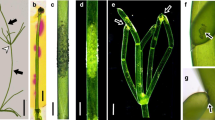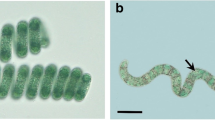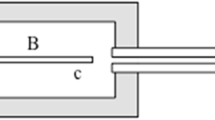Summary
Developing cells ofMicrasterias denticulata Bréb. show a characteristic fluorescence of the plasma membrane (or cortical protoplasm) after treatment with chlorotetracycline (CTC), which is known to be an indicator for membrane-bound Ca2+. Depending on the stage of development the fluorescing sites of the young half cell are distributed in a specific pattern which corresponds to cell pattern formation. Therefore growth and thus cytomorphogenesis inMicrasterias seem to be mediated by a patterned accumulation of Ca2+ at the periphery of the differentiating cell. Participation of Ca2+ in a membrane-recognition process responsible for local vesicle incorporation is discussed.
Similar content being viewed by others
References
Caswell, A. H., 1972: The migration of divalent cations in mitochrondria visualized by a fluorescent chelate probe. L. Membr. Biol.7, 345–364.
— 1979: Methods for measuring intracellular calcium. Int. Rev. Cytol.56, 145–181.
—,Hutchison, J. D., 1971: Selectivity of chelation to tetracyclines: evidence for special conformation of calcium chelate. Biochem. Biophys. Res. Com.43, 3, 625–630.
Chandler, D. E., Williams, J. A., 1978a: Intracellular divalent cation relase in pancreatic acinar cells during stimulus-secretion coupling. I. Use of chlorotetracycline as fluorescent probe. J. Cell Biol.76, 371–385.
— — 1978b: Intracellular divalent cation release in pancreatic acinar cells during stimulus-secretion coupling. II. Subcellular localisation of the fluorescent probe chlorotetracycline. J. Cell Biol.76, 386–399.
Gratzl, M., 1980: Transport of membranes and vesicle contents during exocytosis. In: Biological chemistry of organelle formation (Bücher, Th., Sebald, W., Weiss, H., eds.). Berlin-Heidelberg-New York: Springer.
Jaffe, L. A., Weisenseel, M. H., Jaffe, L. F., 1975: Calcium accumulations within the growing tips of pollen tubes. J. Cell Biol.67, 488–492.
Jaffe, L. F., 1979: Control of development by ionic currents. In: Membrane transduction mechanism (Cone, R. A., Dowling, J. E., eds.). New York: Raven Press.
Kiermayer, O., 1964: Untersuchungen über die Morphogenese und Zellwandbildung beiMicrasterias denticulata Bréb. Protoplasma59, 382–420.
— 1970a: Elektronenmikroskopische Untersuchungen zum Problem der Cytomorphogenese vonMicrasterias denticulata Bréb. I. Allgemeiner Überblick. Protoplasma69, 97–132.
— 1970b: Causal aspects of cytomorphogenesis inMicrasterias. Ann. N. Y. Acad. Sci.175, 686–701.
— 1973: Feinstrukturelle Grundlagen der Cytomorphogenese. Ber. dtsch. Bot. Ges.86, 287–291.
- 1980: Control of morphogenesis inMicrasterias. In: Handbook of Phycological Methods. Developmental and Cytological Methods (Gantt, E., ed.) Cambridge University Press.
— 1981: Cytoplasmic basis of morphogenesis inMicrasterias. In: Cytomorphogenesis in Plants (Kiermayer, O., ed.). Wien-New York: Springer.
Reiss, H. D., Herth, W., 1978: Visualization of the Ca2+-gradient in growing pollen tubes ofLilium longiflorum with chlorotetracycline fluorescence. Protoplasma97, 373–377.
— — 1979: Calcium gradients in tip growing plant cells visualized by chlorotetracycline fluorescence. Planta146, 615–621.
Saunders, M. J., Hepler, P. K., 1981: Localisation of membrane associated calcium following cytokinin treatment inFunaria using chlorotetracycline. Planta152, 272–281.
Sievers, A., Schnepf, E., 1981: Morphogenesis and polarity of tubular cells with tip growth. In: Cytomorphogenesis in Plants (Kiermayer, O., ed.). Wien-New York: Springer.
Täljedal, I. B., 1978: Chlorotetracycline as a fluorescent Ca2+ probe in pancreatic islet cells. Methodological aspects and effects of alloxan, sugars, methylxanthines and Mg2+. J. Cell Biol.76, 652–674.
Waris, H., 1950: Cytophysiological studies onMicrasterias. I. Nuclear and cell division. Physiol. Plant.3, 1–16.
Weisenseel, M. H., Jaffe, L. F., 1976: The major growth current through lily pollen tubes enters as K+ and leaves as H+. Planta133, 1–7.
—,Kicherer, R. M., 1981: Ionic currents as control mechanism in cytomorphogenesis. In: Cytomorphogenesis in Plants (Kiermayer, O., ed.). Wien-New York: Springer.
—,Nuccitelli, R., Jaffe, L. F., 1975: Large electrical currents traverse growing pollen tubes. J. Cell Biol.66, 556–567.
Author information
Authors and Affiliations
Rights and permissions
About this article
Cite this article
Meindl, U. Local accumulation of membrane-associated calcium according to cell pattern formation inMicrasterias denticulata, visualized by chlorotetracycline fluorescence. Protoplasma 110, 143–146 (1982). https://doi.org/10.1007/BF01281541
Received:
Accepted:
Issue Date:
DOI: https://doi.org/10.1007/BF01281541




